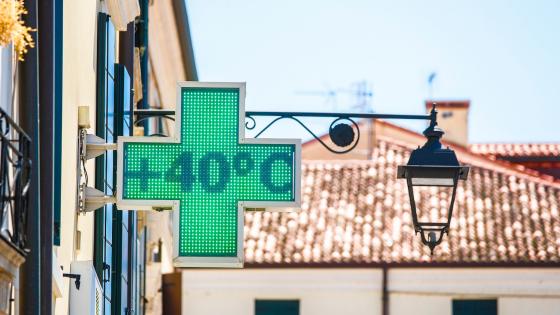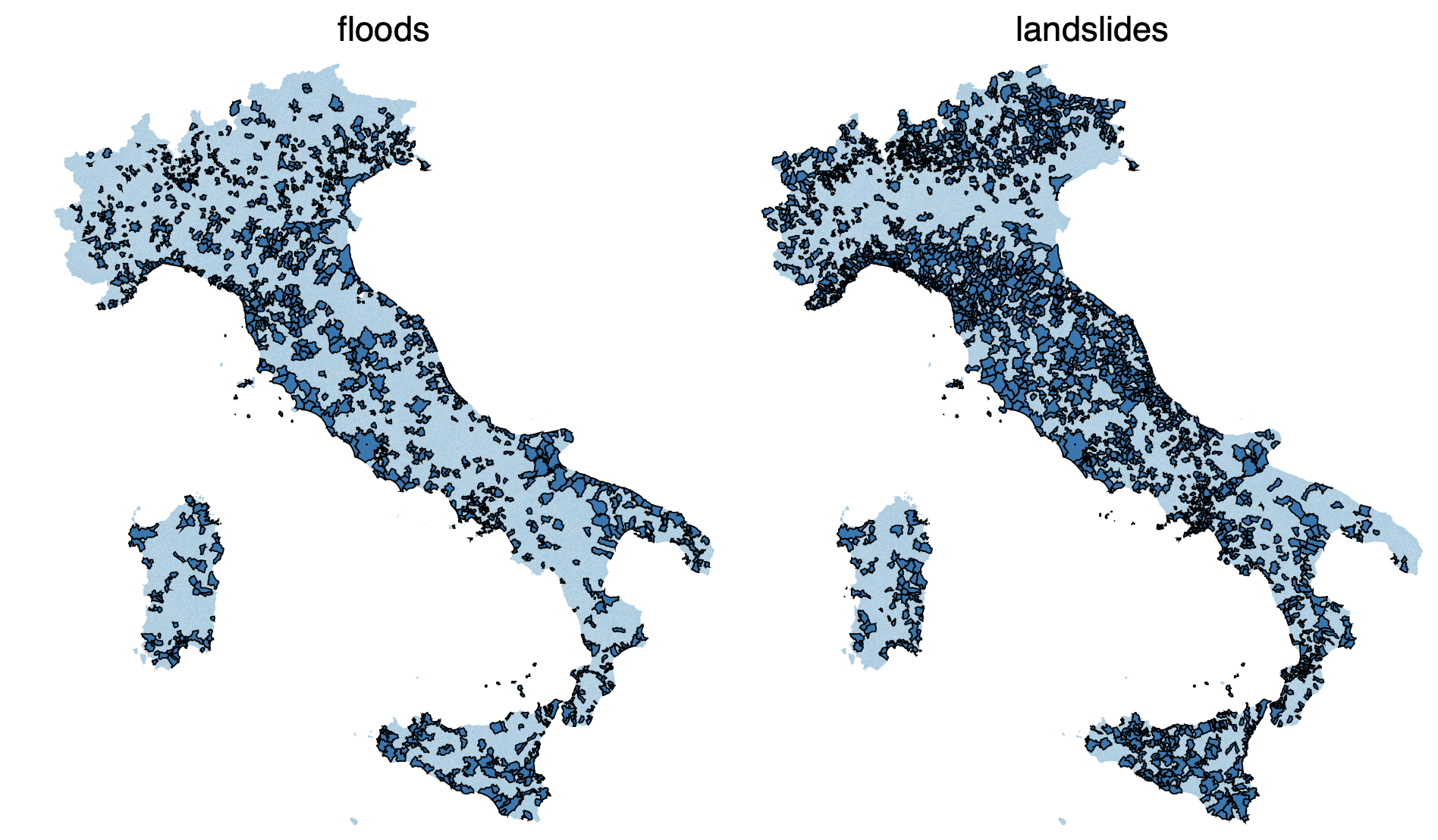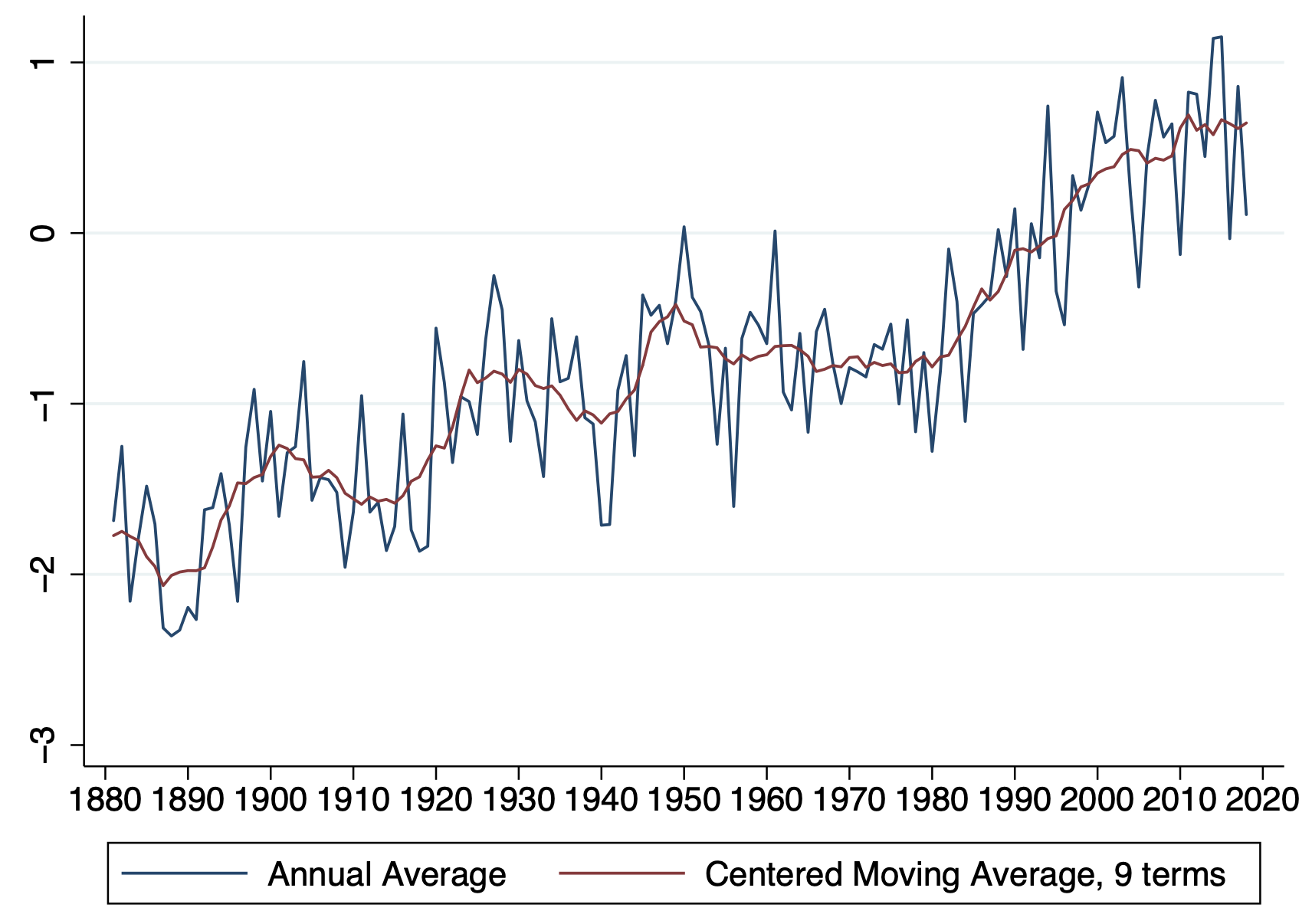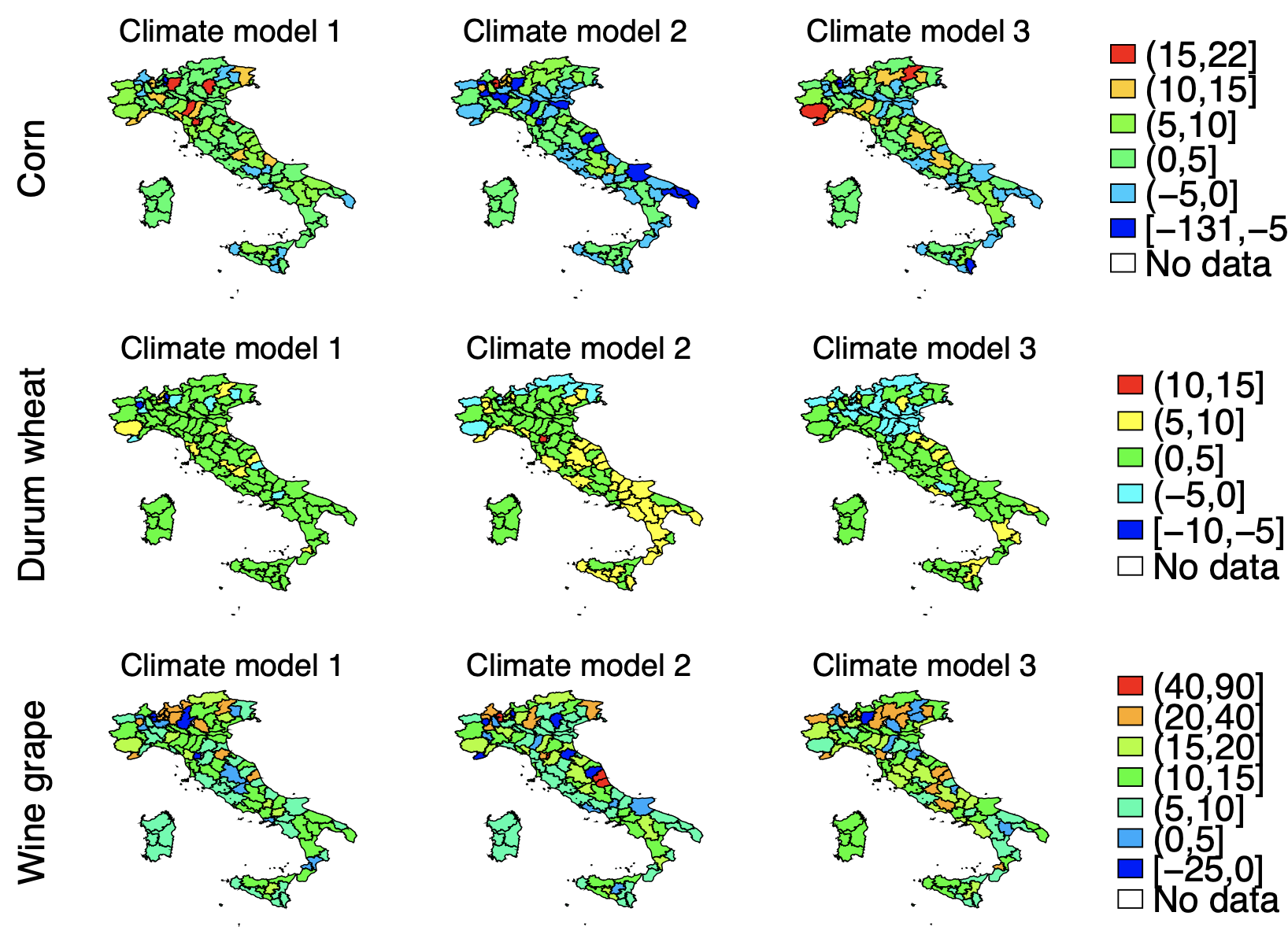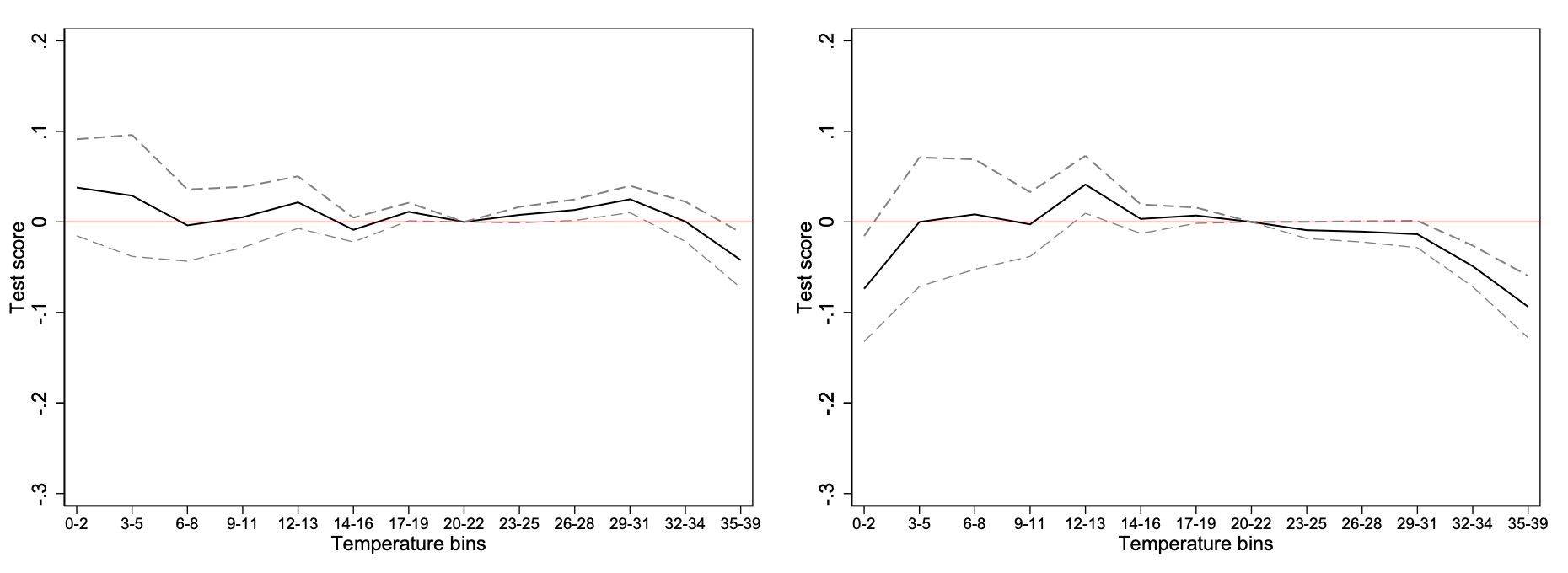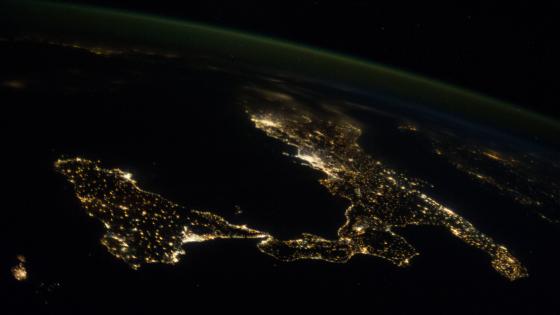As mentioned by Olivier Blanchard and Jean Tirole in the report, The major future economic challenges (Blanchard and Tirole 2021), “[c]limate change poses an existential threat. It will generate tremendous economic costs, jeopardize ecosystems and biodiversity, bring about social unrest, provoke wide scale migration, and create a resentment from poor and middle-income countries that might trigger wars or other forms of conflict.” It comes at no surprise then that climate change issues have now gained a central place in economists’ analyses, as well as in discussions among policymakers. The literature has highlighted an important aspect: the effects of climate change are going to be highly heterogeneous across space, both because its severity will vary across areas and because the responses of the affected economies will be different (e.g. Robert-Nicoud and Peri 2021, Rossi-Hansberg and Cruz 2021). If economists are to offer clear guidance on the appropriate stance of climate change policy, we need impact estimates disaggregated at a fine geographical detail. To this aim, the Italian central bank recently promoted a research project entitled “The effects of climate change on the Italian economy. A Bank of Italy research project,” bringing together some of the Bank’s economists with academic researchers in geology, climatology, and economics. This column summarises some of the findings of the research project with reference to the estimates of the damages on the socio-economic system. Most of these estimates refer to the effect of weather or adverse events at impact, and do not take into account the role of adaptation. A companion column will discuss some of the results of papers that have considered policies for mitigation and adaptation.
Why Italy is an interesting case
Italy makes an interesting case study when it comes to the physical risk posed by climate change. According to the Euro-Mediterranean Centre on Climate Change, the Mediterranean area will experience 20% higher warming than the global average. For Italy specifically, different models predict an average surface temperature increase up to 2° C during the period 2021-2050 relative to 1981-2010. However, in the most severe scenarios, the temperature rise will be much higher. The central and southern regions of Italy are expected to experience a decrease in summer precipitation, accompanied by an increase in its intensity. Furthermore, there will be a general increase in the frequency of extreme weather events.
Italy is highly vulnerable to hydrogeological risk, both due to natural and anthropogenic factors (Trigila et al. 2013). From a geological perspective, the soils and rocks that comprise the mountainous and hilly regions largely consist of weak material, making them highly susceptible to landslides. On the other hand, the plains are prone to flooding. In addition to these natural characteristics, there has been significant anthropogenic activity, expanding into territories that are exposed to high hydrogeological risk.
Figure 1 Municipalities hit by a hydro-geological hazard between 2010 and 2018: Landslides (left panel) and floods (right panel)
Source: SECAGN (Semantic Engine to Classify and Geotag News).
Lessons from past weather changes
In Italy temperatures have been steadily increasing over the past century. Based on an original reconstruction obtained with the anomaly method, Brunetti et al. (2022) show that from the late 19th century to the early 21st century average yearly surface temperature in Italy increased by about 2°C (Figure 2).For more information about the methodology, see Brunetti et al. (2006). The dynamic was rather uniform across provinces, although the rise was slightly higher in the North.
Figure 2 Temperature in deviations from the 1990-1999 average
Source: Brunetti et al. (2022).
Equipped with this reconstruction, the authors estimate the relationship between average decennial temperatures and GDP per capita over the 1871-2001 period using panel data techniques as in Dell et al (2009). The authors find that the relationship is nonlinear, taking on an inverted-U shape, and with a point of inversion at approximately 15°C, beyond which the relationship becomes negative. Based on these estimates, the authors compute the possible future impact of temperature increases on GDP per capita up to the end of the century. Starting from a baseline scenario of 2% annual GDP growth with stable temperatures for the next 80 years (essentially reflecting the historical trend) the authors find that a temperature increase of 1.5°C, which is consistent with an intermediate scenario of future emissions (the scenario coded as SSP2-4.5), would result in a GDP per capita loss between 2.8% and 9.5% by 2100. This corresponds to a decrease in the average annual growth between 0.04 and 0.13 percentage points.
Impacts on sectors and markets
In terms of physical risk posed by climate change, agriculture is the most exposed sector; this is because temperature and precipitation are inputs in the crop production function. Accetturo and Alpino (2022) estimate the effect of weather shocks at the annual frequency on agricultural yields, focusing on three of the main agricultural crops grown in Italy (corn, durum wheat, and grape for winemaking), which are heterogeneous in terms of production region, growing season, and weather requirements. Again, the estimated relationship between the outcome of interest, i.e. yield, and temperature is non-linear: positive below a given threshold (approximately 28° for cereals and 32° for grapevine) and negative above. These estimates, combined with climate projections under a moderately optimistic scenario (coded as A1B) at a fine level of geographical disaggregation (Duveiller et al. 2017), imply that the average effect across Italy would be non-negative in 2030 for the three crops considered, although with some regional heterogeneity (see Figure 3). However, it is plausible that further increases in temperature over the following decades (or even sooner, if climate projections are too optimistic) will determine an overall negative effect.
Figure 3 Projected effect of climate change on yields in 2030 relative to 2000 (percentage change)
Note: climate models 1, 2 and 3 refer to DMI-HIRHAM5-CHAM5, ETHZ-CLM-HadCM3Q0 and METO-HCHadRM3Q0-HadCM3Q0 respectively.
Source: Accetturo and Alpino (2022).
Climate change will have major repercussions on tourism, especially in its mountain component that is most exposed to rising temperatures and falling snowfall. Mariani and Scalise (2022) quantify the effect of diminished snowfall on tourist flows to Alpine (Valle d’Aosta and Trentino-Alto Adige/Südtirol) resorts during the winter season, focusing both on the number of ski passes and on the number of overnight stays. By using panel data techniques, the authors show that decreasing snowfall has already had a negative impact on passes and stays over the 2001-2019 period. Their results suggest that a 40% reduction in the amount of snow over a season (which is the central projection for 2100 according to Jacob et al. (2014) would imply a 7% decrease in passes and stays, which could be far more severe in locations that are at lower altitudes. Moreover, artificial snow cannot support the tourist demand linked to winter sports. At the same time, Alpine resorts with a wider and more varied set of accommodation and culture on offer seem better placed to cope with the reduction in economic activity caused by climate change. Agriculture and tourism are naturally exposed sectors, given the importance of climatic aspects to their business. However, the negative effects of rising temperatures are also felt in manufacturing and services (as analysed by Cascarano et al. 2022a, 2022b). In particular, high temperatures affect firm demography by reducing the entry of new-born firms in the market and increasing business closures, while relocation to colder areas is negligible. With reference to the real estate sector, Cascarano and Natoli (2022) find that that extremely hot temperatures (above 25°C) have a negative effect on house prices even in the short term; they also provide evidence that part of this effect is due to the negative impact of heat on search activities by potential buyers.
According to the Centre for Research on the Epidemiology of Disasters (CRED), between 1998 and 2017, hydrogeological events, particularly landslides and floods, resulted in more than 160,000 deaths worldwide, with economic losses estimated at $660 billion (UNISDR-CRED 2018). Clò et al. (2022) analyse the impact of hydrogeological disasters on Italian firms. They retrieve information on landslides and floods from a database developed by the Department of Earth Sciences of the University of Florence based on an algorithm called SECAGN (Semantic Engine to Classify and Geotag News), which researches and ranks the news of hydrogeological events published on the web (for more information on this data source, see Franceschini et al. 2022). Clò et al. (2022) estimate whether adverse weather events have an effect on companies’ probability of survival and, for those still in the market, a different economic performance.
Their results highlight that adverse hydrogeological events significantly affect the business sector. Firms located in municipalities affected by landslides or floods have experienced a 4.8% higher probability of exiting the market, every year, with respect to firms in non-affected areas. The effect is concentrated on micro- and small enterprises, while it is not significant for medium and large enterprises. With reference to the performance of the surviving companies, in the three years following the shock, revenues and employees are respectively 4.2% and 1.9% lower on average, compared to a counterfactual scenario with no landslides or floods. These effects are eventually absorbed, but this occurs only after approximately five years. The analysis also shows that the negative impact is concentrated on smaller companies and on construction and services companies. Whether an area was more exposed to hydrogeological risk to start with had no bearing on the findings. This suggests either a lack in awareness of these risks or inadequate preparation to face its consequences.
Temperature and human capital
According to the medical literature, higher temperatures can negatively affect human performance (e.g. Hocking et al. 2001). Ballatore et al. (2022) relate the performance of Italian students in a mandatory school test to the temperatures recorded on the day of the exam, using administrative data on standardised scores. They find that when the temperature is higher than 30°C students perform significantly worse (especially on quantitative questions – Figure 4) and they are more likely to suffer from emotional disruption, as measured by an ancillary survey. Effects are stronger among younger kids (2nd and 5th grade) relative to older ones (8th and 10th grade). Note that these are short term effects, and thus do not take into account the possibility that students will adapt to persistently higher temperatures.
Figure 4 Estimated effect of temperature on the day of the test on the score: Verbal (left) and mathematics (right)
Note: Temperatures are binned in intervals of three degrees; the omitted category is 20-22° C.
Source: Ballatore et al. (2022).
Other pollutants
Finally, it is important to recall that emissions of climate-changing greenhouse gases are usually coupled with emissions of other pollutants, which can have direct local effects on health and other outcomes in the areas where they are released (e.g. Neidell et al. 2022). Depalo and Palma (2022) estimate the effect of air pollution on work accidents using administrative data. Leveraging on an instrumental variable strategy that exploits winter heating regulation to address the endogeneity of air quality, they find that pollution increases the number of moderately serious work accidents, but not of fatal ones. The increase in accidents implies a significant cost for the national health system, but also for private firms, due to production disruptions and compensation owed to the affected workers.
Within-country heterogeneity
The results of the Bank of Italy’s research project show significant heterogeneity in impact within the country. For example, Cascarano et al. (2022a) highlight that the effects on firm demography are most intense in the ‘Mediterranean zone’, which includes the coastal strip of the peninsula along with Sicily and Sardinia. Similarly, Clò et al. (2022) document that hydro-geological events have stronger impacts in southern and rural areas. On the other hand, Accetturo and Alpino (2022) find climate change might initially benefit winemakers located in the Alpine region. These findings add a dimension to the priorities for adaptation policies: to the extent that local economic systems have different sensitivity to climate shocks, public resources would involve also allocating spending according to the areas’ resilience. However, they also highlight that the effects of climate change can be particularly unfortunate in that they materialise in areas that are already suffering economically and for which policy remedies have proven to be nearly insufficient (e.g. Barone and de Blasio 2023).
Authors’ Note: The project benefited from the advice of Valentina Bosetti (Bocconi University), Giovanni Marin (University of Urbino), and Alessandro Palma (GSSI, L'Aquila).
References
Accetturo, A and M Alpino (2022), "Climate Change and Italian Agriculture: Evidence from weather shocks", mimeo.
Ballatore, R M, A Palma and D Vuri (2022), "In a Hotter World. The Effect of Temperature on Students’ Performance", mimeo.
Barone, G and G de Blasio (2023), “Place-based policies in the Italian case, part 1: A lot of money for little or no growth”, VoxEU.org, 31 January.
Blanchard, O and J Tirole (2021), Major Future Economic Challenges, République Française, June.
Brunetti, M, M Maugeri, F Monti and T Nanni (2006), “Temperature and precipitation variability in Italy in the last two centuries from homogenised instrumental time series”, International Journal of Climatology 26(3): 345-381.
Brunetti, M, P Croce, M Gomellini and P Piselli (2022), "Temperature dynamics and economic activity in Italy: a long-term analysis", mimeo.
Cascarano, M and F Natoli (2022), "Heat makes markets cold: climate change and housing search", mimeo.
Cascarano, M, F Natoli and A Petrella (2022a), “Entry, exit and market structure in a changing climate”, MPRA Paper No. 112868, University Library of Munich.
Cascarano, M, F Natoli and A Petrella (2022b), “The long-run effects of climate change on the corporate sector: The case of Italy”, VoxEU.org, 18 May.
Clò, S, F David and S Segoni (2022), "The impact of Hydro-geological hazards on Italian firms", mimeo.
Depalo, D and A Palma (2022), "Occupational Accidents and Pollution", mimeo.
Dell, M, B Jones and B Olken (2009), “Does climate change affect economic growth?”, VoxEU.org, 6 June.
Duveiller, G, M Donatelli, D Fumagalli, A Zucchini, R Nelson and B Baruth (2017), “A dataset of future daily weather data for crop modelling over Europe derived from climate change scenarios”, Theoretical and Applied Climatology 127: 573-585.
Franceschini, R, A Rosi, F Catani and N Casagli (2022), “Exploring a landslide inventory created by automated web data mining: the case of Italy”, Landslides 19: 841-853.
Hocking, C, R B Silberstein, W M Lau, C Stough and W Roberts (2001), “Evaluation of cognitive performance in the heat by functional brain imaging and psychometric testing”, Comparative Biochemistry and Physiology Part A: Molecular & Integrative Physiology 128(4): 719-734.
Jacob, D, J Petersen et al. (2014), “EURO-CORDEX: new high-resolution climate change projections for European impact research”, Regional Environmental Change 14: 563-578.
Mariani, G M and D Scalise (2022), "Climate Change and Winter Tourism: Evidence from Italy", mimeo.
Neidell, M, H Dwyer, J G Zivin, S Aguilar-Gomez (2022), “Damage from air pollutants you won’t hear about from your doctor”, VoxEU.org, 30 June.
Robert, Nicoud, F and G Peri (2021), “On the economic geography of climate change”, VoxEU.org, 11 October.
Rossi-Hansberg, E and J-L Cruz (2021), “Unequal gains: Assessing the aggregate and spatial economic impact of global warming”, VoxEU.org, 2 March.
Trigila, A, P Frattini, N Casagli, F Catani, G Crosta, C Esposito, C Iadanza, D Lagomarsino, G S Mugnozza, S Segoni, D Spizzichino, V Tofani and S Lari (2013), “Landslide Susceptibility Mapping at National Scale: The Italian Case Study”, Landslide Science and Practice, p. 287-295.
UNISDR-CRED (2018), Economic losses, poverty & disasters: 1998-2017, United Nations Office for Disaster Risk Reduction.
